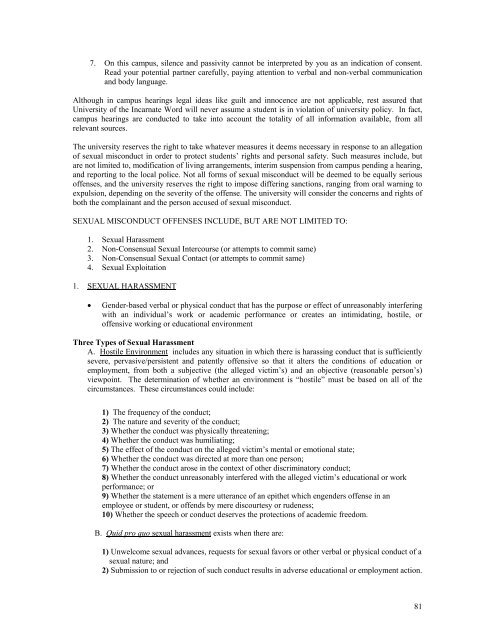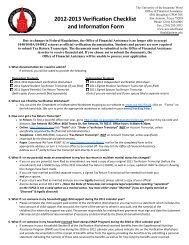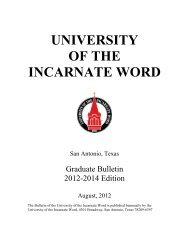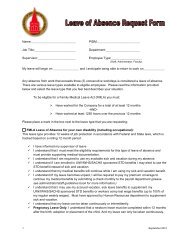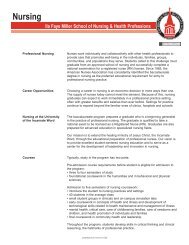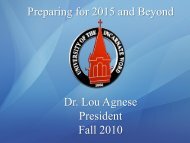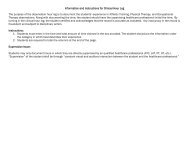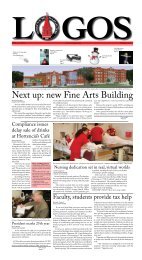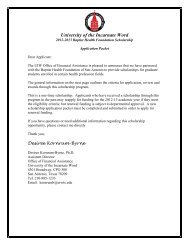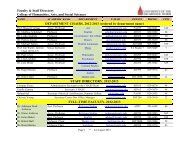2006-2007 Student Handbook - University of the Incarnate Word
2006-2007 Student Handbook - University of the Incarnate Word
2006-2007 Student Handbook - University of the Incarnate Word
Create successful ePaper yourself
Turn your PDF publications into a flip-book with our unique Google optimized e-Paper software.
7. On this campus, silence and passivity cannot be interpreted by you as an indication <strong>of</strong> consent.Read your potential partner carefully, paying attention to verbal and non-verbal communicationand body language.Although in campus hearings legal ideas like guilt and innocence are not applicable, rest assured that<strong>University</strong> <strong>of</strong> <strong>the</strong> <strong>Incarnate</strong> <strong>Word</strong> will never assume a student is in violation <strong>of</strong> university policy. In fact,campus hearings are conducted to take into account <strong>the</strong> totality <strong>of</strong> all information available, from allrelevant sources.The university reserves <strong>the</strong> right to take whatever measures it deems necessary in response to an allegation<strong>of</strong> sexual misconduct in order to protect students’ rights and personal safety. Such measures include, butare not limited to, modification <strong>of</strong> living arrangements, interim suspension from campus pending a hearing,and reporting to <strong>the</strong> local police. Not all forms <strong>of</strong> sexual misconduct will be deemed to be equally serious<strong>of</strong>fenses, and <strong>the</strong> university reserves <strong>the</strong> right to impose differing sanctions, ranging from oral warning toexpulsion, depending on <strong>the</strong> severity <strong>of</strong> <strong>the</strong> <strong>of</strong>fense. The university will consider <strong>the</strong> concerns and rights <strong>of</strong>both <strong>the</strong> complainant and <strong>the</strong> person accused <strong>of</strong> sexual misconduct.SEXUAL MISCONDUCT OFFENSES INCLUDE, BUT ARE NOT LIMITED TO:1. Sexual Harassment2. Non-Consensual Sexual Intercourse (or attempts to commit same)3. Non-Consensual Sexual Contact (or attempts to commit same)4. Sexual Exploitation1. SEXUAL HARASSMENT• Gender-based verbal or physical conduct that has <strong>the</strong> purpose or effect <strong>of</strong> unreasonably interferingwith an individual’s work or academic performance or creates an intimidating, hostile, or<strong>of</strong>fensive working or educational environmentThree Types <strong>of</strong> Sexual HarassmentA. Hostile Environment includes any situation in which <strong>the</strong>re is harassing conduct that is sufficientlysevere, pervasive/persistent and patently <strong>of</strong>fensive so that it alters <strong>the</strong> conditions <strong>of</strong> education oremployment, from both a subjective (<strong>the</strong> alleged victim’s) and an objective (reasonable person’s)viewpoint. The determination <strong>of</strong> whe<strong>the</strong>r an environment is “hostile” must be based on all <strong>of</strong> <strong>the</strong>circumstances. These circumstances could include:1) The frequency <strong>of</strong> <strong>the</strong> conduct;2) The nature and severity <strong>of</strong> <strong>the</strong> conduct;3) Whe<strong>the</strong>r <strong>the</strong> conduct was physically threatening;4) Whe<strong>the</strong>r <strong>the</strong> conduct was humiliating;5) The effect <strong>of</strong> <strong>the</strong> conduct on <strong>the</strong> alleged victim’s mental or emotional state;6) Whe<strong>the</strong>r <strong>the</strong> conduct was directed at more than one person;7) Whe<strong>the</strong>r <strong>the</strong> conduct arose in <strong>the</strong> context <strong>of</strong> o<strong>the</strong>r discriminatory conduct;8) Whe<strong>the</strong>r <strong>the</strong> conduct unreasonably interfered with <strong>the</strong> alleged victim’s educational or workperformance; or9) Whe<strong>the</strong>r <strong>the</strong> statement is a mere utterance <strong>of</strong> an epi<strong>the</strong>t which engenders <strong>of</strong>fense in anemployee or student, or <strong>of</strong>fends by mere discourtesy or rudeness;10) Whe<strong>the</strong>r <strong>the</strong> speech or conduct deserves <strong>the</strong> protections <strong>of</strong> academic freedom.B. Quid pro quo sexual harassment exists when <strong>the</strong>re are:1) Unwelcome sexual advances, requests for sexual favors or o<strong>the</strong>r verbal or physical conduct <strong>of</strong> asexual nature; and2) Submission to or rejection <strong>of</strong> such conduct results in adverse educational or employment action.81


